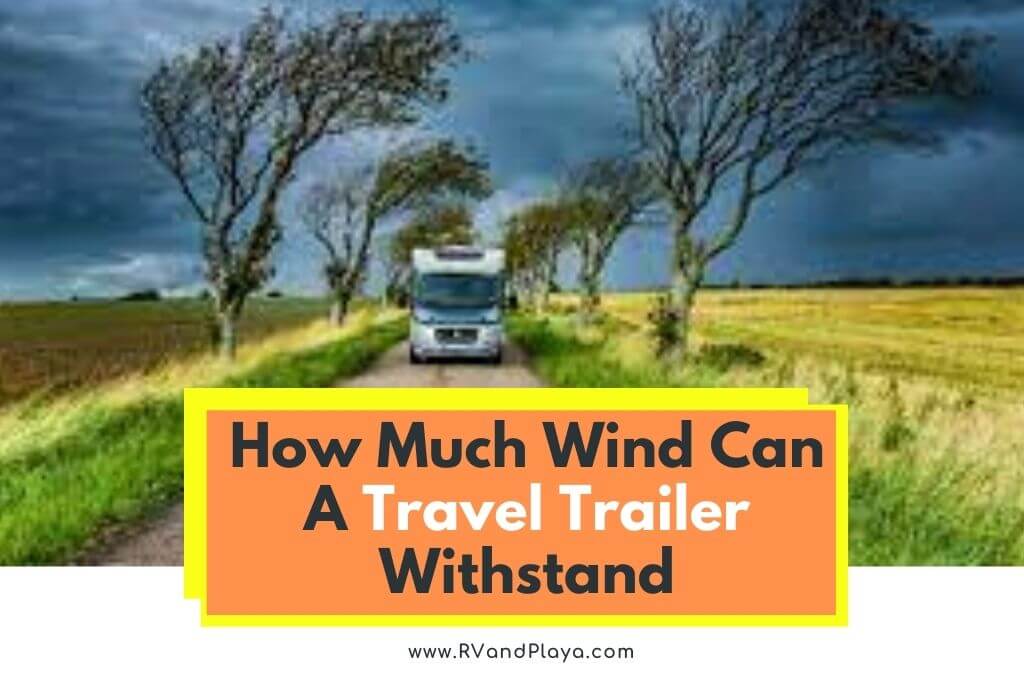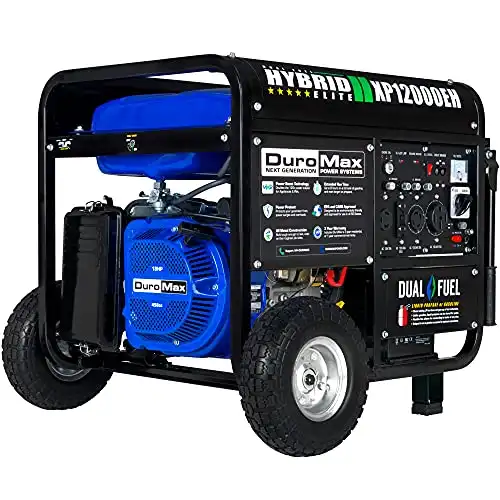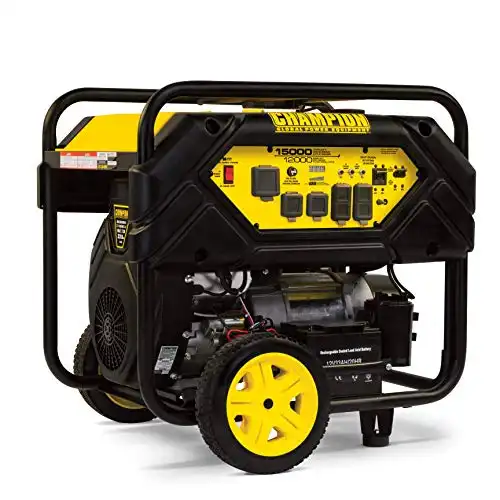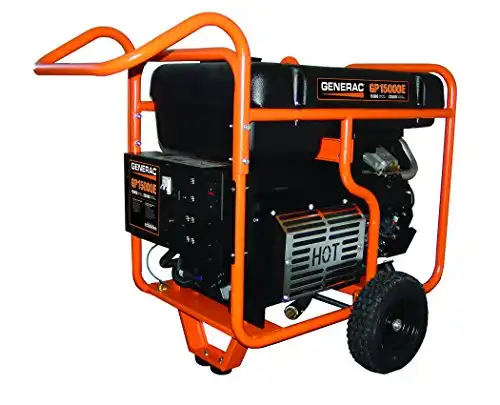Have you ever wondered how much wind a travel trailer parked or moving can withstand? Look no more. We´ve got you covered.
A travel trailer is a specific type of recreational vehicle that hooks to the back of your vehicle. Many people group it in with traditional RVs simply because the word “RV” is easier to say.
Although these vehicles are super fun and generally safe, they are not designed to withstand everything.
So, how much wind can a travel trailer withstand? On average a parked travel trailer can withstand wind speeds of 75 mph (120 km/h) without tipping over, while a moving travel trailer can withstand wind speeds of 30 mph (48 km/h). Moving RVs are much more susceptible to being blown over than parked RVs.
For example, an 18-foot travel trailer can withstand about 53 mph, whereas motorhomes can handle 73 mph.
Travel trailers cannot hold up to high winds. In fact, you need to be incredibly careful when the winds get up high, whether you are in the RV or not.
High winds can not only damage the travel trailer, but it can flip it entirely. This can cause real damage and harm to both you and your trailer.
Let’s get started.
Table of Contents
How Much Wind Can A Travel Trailer Withstand?
A lot of factors affect how much wind a travel trailer can withstand. For example, the travel trailer’s size, whether or not it is moving, and the angling of the wind can all change how much wind it is capable of withstanding.
As a rule of thumb, most travel trailers and RVs will flip over if they are traveling down the highway during wind speeds of 30 mph or above.
Most drivers won’t even drive if the wind speeds are above 20 mph to ensure the safety of everyone around.
Parked RVs and travel trailers can handle a bit more wind. The biggest RVs can handle up to 100 mph if they are parked.
This means that you should definitely park your vehicle and travel trailer if you are driving it when winds start to kick up.
A 50-Amp generator is one of the most cost-effective and convenient ways to power your RV or home when you’re off-grid.Hurricanes can leave your home off the grid for a week or more. If you evacuate in an RV, you’ll need power too (and it may be a cloudy stretch of days for solar power).Here below are the Best Generators for Hurricane Backup:
|
The Westinghouse 50-Amp RV generator can create 15,000 starting watts and 12,000 running watts. With such an incredible amount of power, it’s no surprise that this is a behemoth of a generator and weighs 352 pounds. |
Champion’s 50-Amp RV generator creates 15,000 starting watts and 12,000 running watts. When you fill the 10.9-gallon tank with gasoline, you can expect nine hours of power. It’s a heavy generator at 330 pounds. |
The Generac 50-Amp RV generator creates an astounding 22,500 watts of starting power and 15,000 watts of running power. At 373 pounds, you may need help maneuvering it. |
The Westinghouse 50-Amp RV generator can create 15,000 starting watts and 12,000 running watts.
With such an incredible amount of power, it’s no surprise that this is a behemoth of a generator and weighs 352 pounds.
Champion’s 50-Amp RV generator creates 15,000 starting watts and 12,000 running watts.
When you fill the 10.9-gallon tank with gasoline, you can expect nine hours of power. It’s a heavy generator at 330 pounds.
The Generac 50-Amp RV generator creates an astounding 22,500 watts of starting power and 15,000 watts of running power.
At 373 pounds, you may need help maneuvering it.
Wind Speed Explained
Knowing how much wind your travel trailer can withstand doesn’t mean a lot if you don’t understand wind speed in the first place.
The Beaufort Scale is a tool that rates wind force for both the land and sea. This scale can help you determine how severe the wind is.
| Force | Wind Speed | Descriptive Term | Effects Observed at Sea | Effects Observed on Land | Safe For RVs? |
|---|---|---|---|---|---|
| 0 | Less than 1 km/h | Calm | Sea surface like a mirror, but not necessarily flat. | Smoke rises vertically. | Yes |
| 1 | 1-5 km/h | Light air | Ripples with the appearance of scales are formed but without foam crests. | The direction of wind shown by smoke drift, but not wind vanes. | Yes |
| 2 | 6-11 km/h | Light breeze | Small wavelets, still short but more pronounced. Crests do not break. When visibility is good, the horizon line always very clear. | The wind felt on the face. Leaves rustle. Ordinary vane moved by wind. | Yes |
| 3 | 12-9 km/h | Gentle breeze | Large wavelets. Crests begin to break. Foam of glassy appearance. Perhaps scattered whitecaps. | Leaves and small twigs in constant motion. Wind extends light flag. | Yes |
| 4 | 20-28 km/h | Moderate breeze | Small waves, becoming longer. Fairly frequent whitecaps. | Raises dust and loose paper. Small branches are moved. | Yes |
| 5 | 29-38 km/h | Fresh breeze | Moderate waves, taking a more pronounced long form. Many whitecaps are formed. Chance of some spray. | Small trees with leaves begin to sway. Crested wavelets form on inland waters. | Moderate |
| 6 | 39-49 km/h | Strong breeze | Large waves begin to form. The white foam crests are more extensive everywhere. Probably some spray. | Large branches in motion. Whistling heard in telephone wires. Umbrellas used with difficulty. | Moderate |
| 7 | 50-61 km/h | Near gale | Sea heaps up and white foam from breaking waves begins to be blown in streaks along the direction of the wind. | Whole trees in motion. Inconvenience felt in walking against the wind. | No |
| 8 | 62-74 km/h | Gale | Moderately high waves of greater length. Edges of crests begin to break into the spindrift. The foam is blown in well-marked streaks along the direction of the wind. | Breaks twigs off trees. Generally impedes progress. Walking into the wind almost impossible. | No |
| 9 | 75-88 km/h | Strong gale | High waves. Dense streaks of foam along the direction of the wind. Crests of waves begin to topple, tumble and rollover. The spray may affect visibility. | Slight structural damage occurs, e.g. roofing shingles may become loose or blow off. | No |
| 10 | 89-102 km/h | Storm | Very high waves with long overhanging crests. Dense white streaks of foam. The surface of the sea takes a white appearance. The tumbling of the sea becomes heavy and shock-like. Visibility affected. | Trees uprooted. Considerable structural damage occurs. | No |
| 11 | 103-117 km/h | Violent storm | Exceptionally high waves. Sea completely covered with long white patches of foam. Visibility affected. | Widespread damage. | No |
| 12 | 118- 133 km/h | Hurricane | Air is filled with foam and spray. Sea is entirely white with foam. Visibility seriously impaired. | Rare. Severe widespread damage to vegetation and significant structural damage possible. | No |
Tools To Help You Know The Wind Speed
In addition to knowing the Beaufort scale, there are also a lot of tools online that you can use to keep track of the wind speeds.
Obviously, check out The Weather Channel, Weather Underground, and the Storm Prediction Channel to learn about conditions near you.
Additionally, set up some sort of APP alert for your phone. You can do this through a variety of different sites.
An APP alert will tell you whenever there is a weather advisory in your area. You also might want to check out the National Weather Service and Wind Alert for predictions and info about wind specifically.
Download Windfinder App to go the extra mile.
Best Sellers in Wind Speed Gauges
Below you can find the best wind speed gauges which include:
- HOLDPEAK 866B Digital Anemometer
- BTMETER BT-100 Handheld Digital Wind Speed Meter Gauge
- Amgaze Digital LCD Backlight Wind Speed Meter Gauge
- Wind Speed Meter, DTOWER
- Kestrel 1000 Pocket Wind Meter
Factors That Impact A Travel Trailer’s Ability To Fight Wind
So far, we’ve only given you a rough estimate about how much travel trailers can withstand, as well as explained wind speed in detail.
Now, let’s look at the factors that determine an individual travel trailer’s ability to fight the wind.
Size
As you probably assume, the number one factor that impacts the travel trailer’s ability to fight wind is its size. Heavier travel trailers tend to fight wind more because they take more power to move them.
At the same time, their increased surface area can make them more of a target.
On the other hand, small travel trailers weigh less, making it easy for them to be blown away, but their smaller surface area means less wind hits them at one time.
For example, an 18-foot travel trailer can actually withstand about 53 mph, whereas motorhomes can handle 73 mph.
This just shows that larger travel trailers and RVs are less susceptible to being affected by the wind.
Because weight and surface area matters a lot when it comes to a travel trailer withstanding wind, it’s best to minimize surface area as best as possible.
This includes putting down any satellites, tarps, or anything else hanging off the RV. This will guarantee that your heavy trailer fights better than a lightweight one.
Moving vs. Parked
Something else that dramatically impacts the travel trailer’s ability to fight wind is whether or not it is moving. Moving RVs are much more susceptible to being blown over than parked RVs.
That is because the motion from being driven can work for or against the wind, causing it to knock the travel trailer off balance.
As we already discussed, parked RVs can handle over twice the amount of wind as driven RVs. With this in mind, you especially need to pull over and park your RV if the wind starts getting treacherous while you are driving.
| Wind Speed (MPH) | Wind Speed (KPH) | Effect on Moving RV |
|---|---|---|
| 10 MPH | 16 KPH | Driving at highway speeds can be noticeably affected |
| 20 MPH | 32 KPH | Driving at highway speeds can be dramatically impaired |
| 30 MPH | 48 KPH | Driving at highway speeds is hazardous (especially with embedded gusts) |
The table below shows how much wind is too much for a travel trailer or an RV (what wind speed is dangerous for towing):
Location
The last factor that largely determines how much wind your travel trailer can withstand is its location. If your RV is parked in an open area, it is much more susceptible to being blown over since there is nothing to buffer the wind.
In contrast, RVs that are parked in forested or more secluded areas are more protected.
The trees, buildings, or foliage provide more of a barrier against the wind, allowing the travel trailer to withstand more wind speed.
For example, some sort of windbreak can decrease the wind speed distance as much as 30 times the original height. Of course, this is a professional windbreak.
Trees that are simply there might not be as effective, but they can still add a lot of protection.
Trailer Aerodynamics
Travel trailer & Caravan Aerodynamics Testing – side view >> Check out the video below:
How To Secure Your Travel Trailer In High Winds
If you are new to using a travel trailer in windy conditions, you might want to know some helpful tips to keep you and your travel trailer safe.
Here are the most important tips to keep in mind so that you can protect your travel trailer in windy conditions:
- Point the front of the RV into the oncoming wind (Do all you can to avoid letting the wind hit you broadside)
- Retract patio awnings.
- TipeStay hitched up if you haul a trailer or fifth-wheel. Extra contact with a heavy object will help you feel more stable inside the RV.
- Release the air to create more contact with your tow vehicle or chassis. (If airbag available)
- Bring in slide outs. (Help to minimize the surface area battered by wind)
- Keep your stabilizing jacks down.
How to secure your travel trailer in high winds – HOW TO SURVIVE HIGH WINDS in your RV — 10 Tips to Stay Alive! >> Check out the video below:
Park The Vehicle
As we’ve already discussed, it’s important to park your vehicle as soon as the wind starts picking up.
Even though certain travel trailers can withstand wind speeds of 30 mph, it’s always a great idea to park your RV if it starts going over 20 mph.
Even though certain travel trailers can withstand wind speeds of 30 mph, it’s always a great idea to park your RV if it starts going over 20 mph.
Parking your vehicle can make a difference in saving your life when conditions become windy. Even though it may take a little bit longer to get to your destination, it will at least allow you to get there safely.
Simply park the vehicle whenever you notice the wind impacting your vehicle and travel the trailer more severely.
As you park your vehicle, don’t make any sudden stops. Sudden stops can cause your travel trailer or RV to tip from the wind.
Slow down slowly as you park, and you may want to avoid leaving the highway entirely if you can.
Read also: RV Accidents Statistics: 19 Facts You Should Know (Explained)
Angle It Where The Wind Is Coming From
Whether you are actively driving, or your RV is simply parked, try to angle it in the direction that the wind is coming from.
This will allow the wind to roll off the RV more smoothly, making it less likely to damage or flip the travel trailer.
There are multiple ways you can learn the wind direction. You can try to feel it, watch the water, or create a wind device. We will go over finding the wind direction in the FAQs section in more detail.
Use Your Stabilizing Jacks
Additionally, make sure to use your stabilizing jacks at this point. This can help keep the travel trailer in place, even when the winds get serious.
It may be annoying to put the stabilizing jacks up during windy conditions, but it can make a big difference down the line.
Lock Up Loose Items
While you are using the stabilizing jacks, look for any loose items outside the travel trailer. This may be chairs, awnings, or anything else you placed outside your travel trailer.
Bringing these items inside will help to prevent them from getting blown away from the wind, leading to a safer surrounding.
It’s also a good idea to put away loose items that are inside. This is especially true of sharp or pointy items.
You do not want dangerous items flopping around with you in the worst-case scenario of the travel trailer toppling.
Bring Children And Pets Inside
Finally, the last thing you need to do is bring all children and pets inside too. It is much more likely for smaller objects to be dislodged than your RV.
If your children and pets are outside, this puts them at risk of being hit by dislodged items.
If the wind is especially bad, to the point that the trailer is at high risk of toppling, you might want to consider looking for a more secure shelter.
A building with a foundation will be best, but this may not be an option while you are camping or on the road. For this reason, it’s always a great idea to have a first aid kit on hand.
Travel Trailer Wind Deflector
Trailer wind deflectors do really work, wind deflectors are more effective than a bubble dome. Even small vehicles pulling small trailers will benefit from a wind deflector.
If your trailer is higher than your tow vehicle, it will create wind drag.
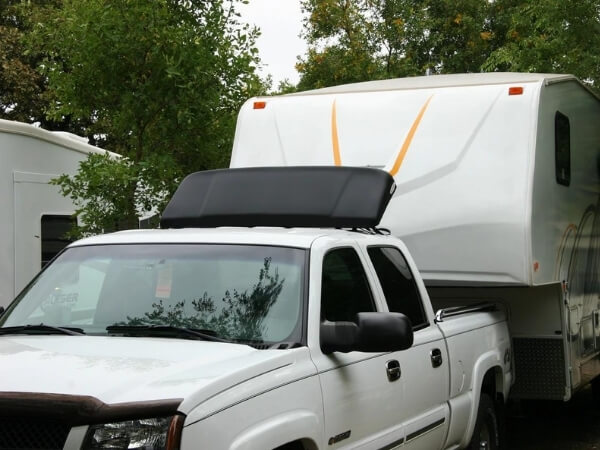
Installing the AeroShield Wind Deflector for Towing Trailers >> Check out the video below:
How Much Wind Can A Travel Trailer Withstand FAQs
Let’s close out this page about Travel trailer wind resistance with answers to some of your most frequently-asked questions about them!
Can I drive in high winds?
Driving in high winds is discouraged. As we learned, travel trailers and RVs are much more likely to tip from the high wind when they are being driven.
If you are on the road when high winds start kicking up, it’s best to simply pull over.
It is generally a rule of thumb that you should pull over whenever the winds exceed 30 mph. Many people like to pull over when winds exceed 20 mph.
Listen to your gut, though. If you feel uncomfortable driving, pull over immediately.
How can I ensure my items are insured against wind damage?
Before you go out in your travel trailer or RV, contact your insurance provider to ensure that it includes wind damage. Make sure your awning is covered too since that is the part that will most likely be damaged by wind.
It’s a good idea to keep your RV and home insurance separate. This will help you save money in the long run.
How can I know which direction the wind is coming from?
If you are trying to park your RV at the angle of the wind, you need to know which direction it is coming from. If the winds are extremely high, you likely will be able to detect the direction simply by feeling it.
Closing your eyes can make it easier for your other senses to determine the direction of the wind.
If there is water nearby, you can also look at the directions of the ripples. The ripples will go in line with the wind direction.
If there’s not a large body of water nearby, you can simply fill up a bucket or pan with water and set it outside.
In the case that the two tips above don’t work, you can even create a little device. For example, you can place a really light cloth or piece of paper on some sort of straw or stick.
Watching which direction the fabric moves tells you the direction of the wind.
Should I keep my travel trailer hitched up in high winds?
If winds start kicking up, it’s a great idea to keep your travel trailer hitched up or re-hitch it up if it is disconnected.
Whenever the travel trailer is connected to the vehicle, it increases the strength and weight. As a result, it is less likely to topple over because of the wind.
5th Wheels In High Winds
Towing 5th wheel camper in 80km/h SIDE WINDS!! (5th wheels in high winds) >> Check out the video below:
Final Thoughts
Travel trailers are pretty durable and have the ability to stand up against average and moderate wind speeds. However, they are not suitable for moderate to high wind speeds. This is especially true if your travel trailer is on the road in motion.
As a rule of thumb, pull over and park your travel trailer if the wind speeds get above 30 mph. Once parked, most travel trailers can withstand up to 100 mph.
Anything over 100 mph typically classifies as hurricane or tornado weather, and you should seek sturdy shelter.
When it comes to how much wind your travel trailer can withstand, just remember to trust your gut. If the wind feels too intense, simply pull over. It’s always better to be safe than sorry when it comes to traveling in your travel trailer.
Wind can be incredibly dangerous. Trust your gut and keep a first aid kit on hand.
References
https://rvlife.com/high-winds-flip-rvs/
https://blog.goodsam.com/how-much-wind-is-too-much-for-your-rv/
Recent Posts
Have you ever wondered how much wind a tent can withstand? Look no more. We´ve got you covered. Tents provide adequate protection from most bugs, rain, and wind when camping outside....
If you are considering a pop up camper as an option to enjoy camping, you may be wondering how much wind a pop-up camper can take. And is it dangerous to camp out in a pop up camper during high wind...

